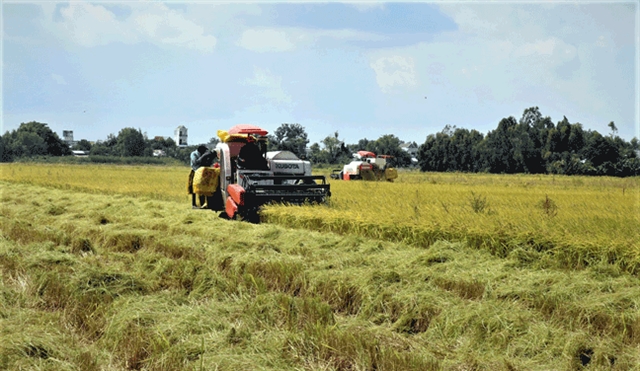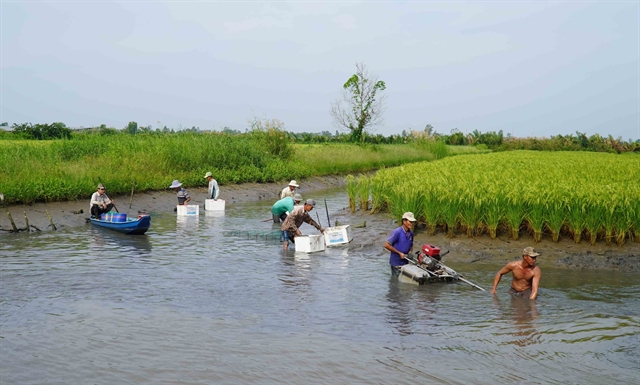 Economy
Economy

 |
| Shrimp - rice fields in Kiên Giang Province’s An Minh District. Shrimp - rice farming is an effective farming model that adapts to climate change, is environmental friendly and sustainable. – VNA/VNS Photo Văn Sĩ |
KIÊN GIANG – Kiên Giang Province plans to increase aquaculture production this year, focusing on high-value species.
The Cửu Long (Mekong) Delta province hopes to produce 390,000 tonnes of seafood, an increase of 1.7 per cent from last year.
Lê Hữu Toàn, director of the province's Department of Agriculture and Rural Development, said zoning has been done for the sustainable development of aquaculture tailored to conditions in each locality while meeting market demand.
The province is expanding farming models involving shrimp-rice, shrimp-mud crab and giant river prawn-black tiger shrimp.
This year it plans to breed shrimp on a total of 137,000 ha using various methods, including industrial, extensive, shrimp-rice, and shrimp-mud crab farming.
These models emphasise breeding shrimp to Vietnamese Good Agricultural Practices (VietGAP) and organic standards to cater to both domestic and export markets.
Kiên Giang also plans to farm fish and other marine species using 4,550 floating cages this year.
It leads the delta in the number of such floating cages, with most marine aquaculture activities concentrated in the island district of Kiên Hải and Phú Quốc City.
It also aims to farm bivalve molluscs over 24,000ha in coastal areas this year, primarily in the districts of An Biên, An Minh and Kiên Lương, with an expected output of 100,000 tonnes.
Freshwater fish and other aquatic species will be farmed across 60,200ha, with plans to develop breeding in rice fields, ponds, ditches, rivers, and canals.
Farmers are encouraged to adopt advanced farming techniques and high-quality standards to meet export requirements.
High-value species such as shrimp, blood cockles, mud crabs, cobia, grouper, pomfret, and pearl oysters provide farmers with significant profits.
To address climate change and enhance productivity, the province is continuing its strategy of converting less productive rice fields into shrimp-rice farming areas.
Farmers alternating between rice and shrimp, cultivating the grain in the rainy season and breeding the crustacean during the dry season, avoid using chemicals and industrial feed, resulting in products that are highly sought after by consumers.
The province is implementing a long-term plan to sustainably develop marine aquaculture by 2030.
This includes expanding marine aquaculture in coastal areas, islands, and offshore zones, while encouraging investment from individuals, companies, and organisations with financial resources and technological expertise.
Kiên Giang’s marine aquaculture plan focuses on value chain development, including the supply of inputs, seed quality checks, and disease monitoring, to ensure sustainable growth.
With 143 islands and a coastline of more than 200km, Kiên Giang has significant potential for marine aquaculture development.
Its waters are rich in high-value aquatic species, creating favourable conditions for preserving and cultivating aquatic resources.
It has identified the marine economy as a key sector, prioritising the sustainable development of aquaculture across the mainland, near-shore and offshore areas.
It has also encouraged investment in marine aquaculture integrated with tourism services.
High profits
Farmers breeding giant river prawns, black tiger shrimp and white-legged shrimp in the same ponds in Kiên Giang have reported high profits due to increased prices in the market.
Last month traders paid VNĐ20,000 (78 US cents) more for the crustaceans than a year earlier.
Farmers earned profits of VNĐ10-15 million (US$400-600) per hectare, significantly higher than in the same period in 2023.
Đoàn Văn Tạo of Vĩnh Bình Bắc Commune, Vĩnh Thuận District, one of first farmers to breed all three species together, has a three-hectare pond and harvested 1.3 tonnes of giant river prawns, 300kg of black tiger shrimp and 600kg of white-legged shrimp last month.
“After deducting costs, I earned a profit of VNĐ210 million ($8,300) from the last harvest, up VNĐ60 million ($2,400) from the same period in 2023,” he said.
Toàn, director of the Department of Agriculture and Rural Development, noted that the high prices of shrimp species have boosted profits for farmers and positively impacted aquaculture recovery in the province.
The department plans to intensify of aquatic brood stocks for quality, provide farmers with bio-safety breeding techniques and closely monitor and prevent disease outbreaks.
It will also collaborate with relevant agencies to manage irrigation systems for shrimp and crab farming and operate automatic water quality monitoring systems to provide farmers with information about water quality so that they can take measures to protect their stocks.
The area under aquaculture has grown steadily in Kiên Giang in recent years, with the province achieving an output of over 384,170 tonnes last year, a 6 per cent increase from 2023.
The value of its aquaculture output reached VNĐ152.5 million ($6,000) per hectare last year, up from VNĐ130.4 million ($5,100) in 2021. – VNS